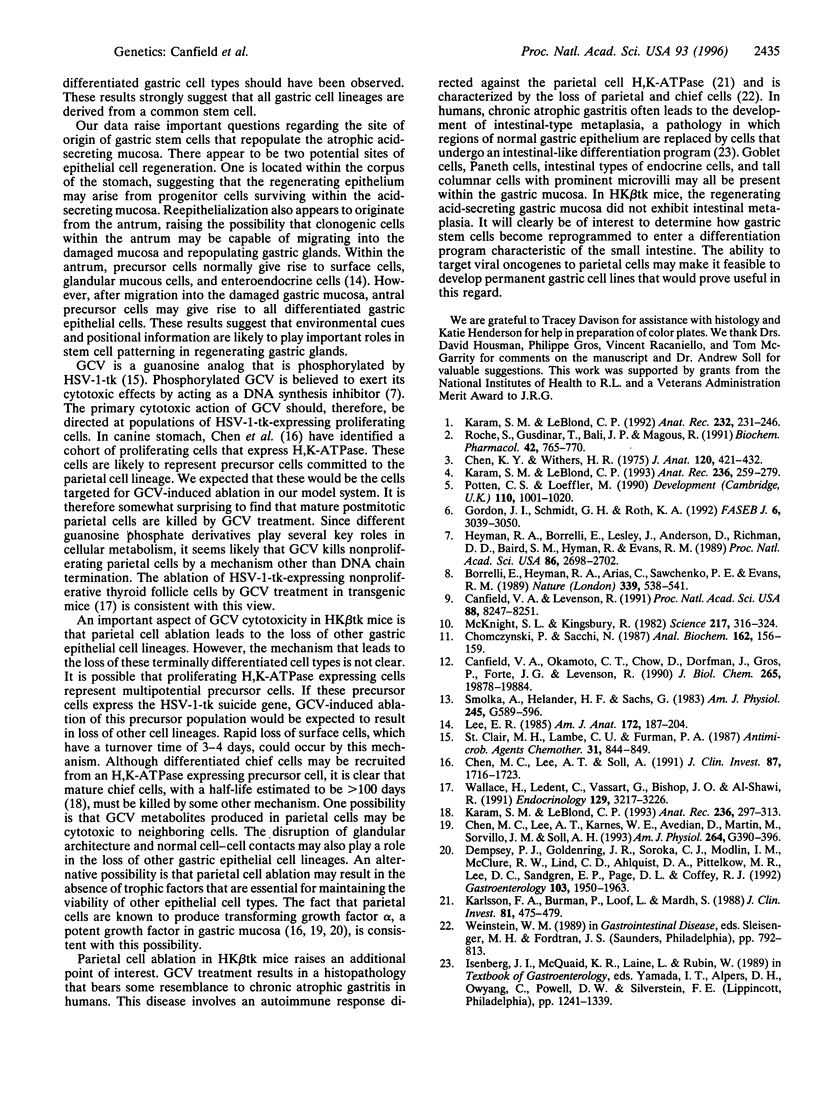Abstract
The gastric mucosa of mammalian stomach contains several differentiated cell types specialized for the secretion of acid, digestive enzymes, mucus, and hormones. Understanding whether each of these cell lineages is derived from a common stem cell has been a challenging problem. We have used a genetic approach to analyze the ontogeny of progenitor cells within mouse stomach. Herpes simplex virus 1 thymidine kinase was targeted to parietal cells within the gastric mucosa of transgenic mice, and parietal cells were ablated by treatment of animals with the antiherpetic drug ganciclovir. Ganciclovir treatment produced complete ablation of parietal cells, dissolution of gastric glands, and loss of chief and mucus-producing cells. Termination of drug treatment led to the reemergence of all major gastric epithelial cell types and restoration of glandular architecture. Our results imply the existence of a pluripotent stem cell for the gastric mucosa. Parietal cell ablation should provide a model for analyzing cell lineage relationships within the stomach as well as mechanisms underlying gastric injury and repair.
Full text
PDF




Images in this article
Selected References
These references are in PubMed. This may not be the complete list of references from this article.
- Borrelli E., Heyman R. A., Arias C., Sawchenko P. E., Evans R. M. Transgenic mice with inducible dwarfism. Nature. 1989 Jun 15;339(6225):538–541. doi: 10.1038/339538a0. [DOI] [PubMed] [Google Scholar]
- Canfield V. A., Levenson R. Structural organization and transcription of the mouse gastric H+, K(+)-ATPase beta subunit gene. Proc Natl Acad Sci U S A. 1991 Sep 15;88(18):8247–8251. doi: 10.1073/pnas.88.18.8247. [DOI] [PMC free article] [PubMed] [Google Scholar]
- Canfield V. A., Okamoto C. T., Chow D., Dorfman J., Gros P., Forte J. G., Levenson R. Cloning of the H,K-ATPase beta subunit. Tissue-specific expression, chromosomal assignment, and relationship to Na,K-ATPase beta subunits. J Biol Chem. 1990 Nov 15;265(32):19878–19884. [PubMed] [Google Scholar]
- Chen K. Y., Withers H. R. Proliferative capability of parietal and zymogen cells. J Anat. 1975 Dec;120(Pt 3):421–432. [PMC free article] [PubMed] [Google Scholar]
- Chen M. C., Lee A. T., Karnes W. E., Avedian D., Martin M., Sorvillo J. M., Soll A. H. Paracrine control of gastric epithelial cell growth in culture by transforming growth factor-alpha. Am J Physiol. 1993 Feb;264(2 Pt 1):G390–G396. doi: 10.1152/ajpgi.1993.264.2.G390. [DOI] [PubMed] [Google Scholar]
- Chen M. C., Lee A. T., Soll A. H. Mitogenic response of canine fundic epithelial cells in short-term culture to transforming growth factor alpha and insulinlike growth factor I. J Clin Invest. 1991 May;87(5):1716–1723. doi: 10.1172/JCI115189. [DOI] [PMC free article] [PubMed] [Google Scholar]
- Chomczynski P., Sacchi N. Single-step method of RNA isolation by acid guanidinium thiocyanate-phenol-chloroform extraction. Anal Biochem. 1987 Apr;162(1):156–159. doi: 10.1006/abio.1987.9999. [DOI] [PubMed] [Google Scholar]
- Dempsey P. J., Goldenring J. R., Soroka C. J., Modlin I. M., McClure R. W., Lind C. D., Ahlquist D. A., Pittelkow M. R., Lee D. C., Sandgren E. P. Possible role of transforming growth factor alpha in the pathogenesis of Ménétrier's disease: supportive evidence form humans and transgenic mice. Gastroenterology. 1992 Dec;103(6):1950–1963. doi: 10.1016/0016-5085(92)91455-d. [DOI] [PubMed] [Google Scholar]
- Gordon J. I., Schmidt G. H., Roth K. A. Studies of intestinal stem cells using normal, chimeric, and transgenic mice. FASEB J. 1992 Sep;6(12):3039–3050. doi: 10.1096/fasebj.6.12.1521737. [DOI] [PubMed] [Google Scholar]
- Heyman R. A., Borrelli E., Lesley J., Anderson D., Richman D. D., Baird S. M., Hyman R., Evans R. M. Thymidine kinase obliteration: creation of transgenic mice with controlled immune deficiency. Proc Natl Acad Sci U S A. 1989 Apr;86(8):2698–2702. doi: 10.1073/pnas.86.8.2698. [DOI] [PMC free article] [PubMed] [Google Scholar]
- Karam S. M., Leblond C. P. Dynamics of epithelial cells in the corpus of the mouse stomach. I. Identification of proliferative cell types and pinpointing of the stem cell. Anat Rec. 1993 Jun;236(2):259–279. doi: 10.1002/ar.1092360202. [DOI] [PubMed] [Google Scholar]
- Karam S. M., Leblond C. P. Dynamics of epithelial cells in the corpus of the mouse stomach. III. Inward migration of neck cells followed by progressive transformation into zymogenic cells. Anat Rec. 1993 Jun;236(2):297–313. doi: 10.1002/ar.1092360204. [DOI] [PubMed] [Google Scholar]
- Karam S. M., Leblond C. P. Identifying and counting epithelial cell types in the "corpus" of the mouse stomach. Anat Rec. 1992 Feb;232(2):231–246. doi: 10.1002/ar.1092320208. [DOI] [PubMed] [Google Scholar]
- Karlsson F. A., Burman P., Löf L., Mårdh S. Major parietal cell antigen in autoimmune gastritis with pernicious anemia is the acid-producing H+,K+-adenosine triphosphatase of the stomach. J Clin Invest. 1988 Feb;81(2):475–479. doi: 10.1172/JCI113344. [DOI] [PMC free article] [PubMed] [Google Scholar]
- Lee E. R. Dynamic histology of the antral epithelium in the mouse stomach: I. Architecture of antral units. Am J Anat. 1985 Mar;172(3):187–204. doi: 10.1002/aja.1001720303. [DOI] [PubMed] [Google Scholar]
- McKnight S. L., Kingsbury R. Transcriptional control signals of a eukaryotic protein-coding gene. Science. 1982 Jul 23;217(4557):316–324. doi: 10.1126/science.6283634. [DOI] [PubMed] [Google Scholar]
- Potten C. S., Loeffler M. Stem cells: attributes, cycles, spirals, pitfalls and uncertainties. Lessons for and from the crypt. Development. 1990 Dec;110(4):1001–1020. doi: 10.1242/dev.110.4.1001. [DOI] [PubMed] [Google Scholar]
- Roche S., Gusdinar T., Bali J. P., Magous R. "Gastrin" and "CCK" receptors on histamine- and somatostatin-containing cells from rabbit fundic mucosa--I. Characterization by means of agonists. Biochem Pharmacol. 1991 Jul 25;42(4):765–770. doi: 10.1016/0006-2952(91)90034-3. [DOI] [PubMed] [Google Scholar]
- Smolka A., Helander H. F., Sachs G. Monoclonal antibodies against gastric H+ + K+ ATPase. Am J Physiol. 1983 Oct;245(4):G589–G596. doi: 10.1152/ajpgi.1983.245.4.G589. [DOI] [PubMed] [Google Scholar]
- St Clair M. H., Lambe C. U., Furman P. A. Inhibition by ganciclovir of cell growth and DNA synthesis of cells biochemically transformed with herpesvirus genetic information. Antimicrob Agents Chemother. 1987 Jun;31(6):844–849. doi: 10.1128/aac.31.6.844. [DOI] [PMC free article] [PubMed] [Google Scholar]
- Wallace H., Ledent C., Vassart G., Bishop J. O., al-Shawi R. Specific ablation of thyroid follicle cells in adult transgenic mice. Endocrinology. 1991 Dec;129(6):3217–3226. doi: 10.1210/endo-129-6-3217. [DOI] [PubMed] [Google Scholar]








